A few years ago I was touring a down-and-out portion of City X (it doesn’t really matter—could be any city) for the first time, when a colleague of mine made the observation: “You can immediately tell that land values are low here; just look at all these used car dealerships!â€Â I concurred without saying anything; I didn’t need to. It seemed like a truism. Of course this area was low-rent. It had bombed-out factories, a trash-clogged creek, the occasional boarded-up house, and retail that is generally not associated with anything but poor neighborhoods. But where did those used car lots fit in?
I’ve since thought about her observation in a number of urban environments that I have visited, large and small, and—no surprise—this correlation plays out everywhere. But the statement needs refinement: not every used car dealership automatically signals depressed real estate. Specifically, the mom-and-pop, unlicensed dealers not tethered to a regionally known last name offer the best examples of cheap land: in other words, the polar opposite of Hubler or Ray Skillman or Pedigo. These dealerships typically look more like this:
Typically these dealerships rest on an important street but not necessarily a major arterial like a state highway (those go for the Hublers and Pedigos). The mom-and-pops often feature the owners’ initials as part of the establishment’s name. Prices are nearly always painted on the cars windshields, and rarely (if ever) are they in the five digits. And usually their inventories are much, much smaller than a licensed dealership, averaging only a few dozen vehicles on display. I must confess that I have never patronized one of these businesses, so I’m speculating here, but I would assume they don’t involve a great deal of finance options, if any. I suspect there are few options for legal recompense if the purchaser finds within a week that he or she has bought a lemon. It’s possible that many of these places expect payment in cash. In short, they cater typically to clientele whose credit and income are likely to prevent them from financing a car. These cars have sifted their way down to these dealerships and may just be a few thousand miles away on the odometer from the junkyard.
So it isn’t a particularly bold statement to suggest that small used dealerships flourish in low-income neighborhoods. Aside from the fact that they are more likely to locate close to their demographic base, these dealerships need cheap land to operate. Obviously they require more space than a convenience store or a tax filing service in order to run the business; their inventory occupies a parking lot. And since the inventory is already significantly devalued, the best way to guarantee a secure profit margin is to operate on land where the per square foot costs are rock bottom.
Many of Indy’s heavily transitional neighborhoods in Center Township are chock full of these mom-and-pop used car dealerships. In fact, the photo above depicts a car lot that many readers here will likely recognize: on Virginia Avenue, just a long block away from the heart of Fountain Square. This neighborhood, predating the automobile and even the interurban, no doubt previously accommodated other land uses where these car lots now exist. While we can pine for what might have been—the low-rise commercial and residential buildings that stood here a generation ago—we can also anticipate what the future holds, particularly in the long-undervalued sites that would be easiest to develop with infill. Thus, I present to our readers a montage of development sites with high potential across neighborhoods represented by Southeast Neighborhood Redevelopment CDC, better known as SEND. The agency focuses on revitalizing a broad enough district to the immediate southeast of downtown Indianapolis (indicated in this map) that it would take me days to chronicle every single used car lot. Instead, I have focused on the ones primarily in four neighborhoods: Fountain Square, Holy Rosary, Fletcher Place, and Bates-Hendricks—neighborhoods which are already experiencing varying degrees of revitalization (some quite far along).  The mom-and-pop used car lot was borne out of low land values in the area; they represent some of the best opportunities at infill as those values rise again over time.
The first photo in the series represents an excellent start point: right near the hub where Virginia Avenue, Shelby Street, and Prospect Avenue all meet. First venture eastward along Prospect; just beyond the edge of Fountain Square’s restaurants and music venues is a fire station, and immediately to its east sits the first used car lot.
Just a block or so further, again on the north side of Prospect Avenue at 1324, sits another.
And a block further, at 1452, is a third:
All three of these lots cluster on a stretch of Prospect before the approach of State Avenue, the next major intersection. The last of the three abuts a gas station, which will always prove a costlier redevelopment opportunity, but 1452 on its own could easily host a denser land use.
And for those who doubt the viability of extending the activity level of Fountain Square this far eastward, bear in mind that the easternmost of these three lots sits more or less across the street from the long-successful Santorini Greek Kitchen.
Proceeding along Virginia Avenue from Fountain Square’s heart, we can easily see land market economics playing out predictably. The aforementioned site of A&M Auto—
–sits at the intersection of Virginia and Woodlawn, a prime spot. A quick check on Google Streetview indicates that the dealership has changed hands since July 2009 (the date of the Streetview photos), which suggests a certain level of liquidity that probably wasn’t there 20 years ago, when Fountain Square was an economically stagnant neighborhood.
A block further along Virginia reveals a used car lot that is very much in a state of transition:
Coop’s was in operation at the time of Google Streetview, but not anymore. The current owner of the property recently sought to build a gas station on the site, which the C-5 zoning classification would allow. Urban Indy covered this mild controversy a few months ago, when the proposal first reached the Indianapolis Historic Preservation Commission (IHPC). Due to overwhelming neighborhood opposition on the prospect of a gas station fronting the Cultural Trail, the developer shelved the plans, and further proposals are forthcoming.
Continuing down Virginia across the interstate reveals another vacant used car lot on the edge of Fletcher Place:
Advance Auto Sales is also no longer in operation. It was for sale three years ago, as indicated from Google Streetview; recent photos reveal the sign has been removed. It doesn’t take a brain surgeon to conclude that the desirability of this leg of Virginia Avenue has increased to the point that the owners of these used car lots have determined that selling their property is a more profitable venture than retaining a business that buys and sells vehicles for less than one grand. Property taxes and other carrying along Virginia Avenue may have risen to the point that running a used car lot no longer makes sense as a business model; Coops and Advance Auto Sales could easily have found depressed real estate in another part of town to continue their operations.
At about this point, Virginia intersects with College Avenue, which proceeds into the heart of the Fletcher Place neighborhood. Continue two blocks northward, and look at the northeast corner at the intersection of College and Fletcher Avenue:
Another used car lot, right next to the neighborhood institution, Iaria’s.
Returning to Virginia Avenue, near the busy intersection of Virginia, Fletcher, South and East Streets sits a final, inconspicuous car lot:
This one, Members Auto Source, LLC, appears to be a slightly different operation—more of an automobile brokerage firm.  It promotes its proximity to the Lilly Corporate Center, so it will be interesting to see if the company remains on this tiny parcel as land values inevitably rise over the next few years.
Turning southward on East Street then crossing I-70, the Bates-Hendricks neighborhood offers a huge array of used car lots. I’m including the most prominent ones with the greatest opportunity for redevelopment, and the East Street intersection with Prospect Avenue and Morris Street provides an unlikely cluster. The first sits at the northeast corner of East and Prospect:
Immediately to the south of it, on the southeast corner of that same intersection, sits another.
Directly abutting that lot and again to the south (on the east side of East Street) is a third:
And, separated only by an alley, a fourth lot sits immediately to the south, looking particularly underutilized:
Standing at the southwest corner of Morris Street and looking in a northeastward direction, it is easy to see the four used car lots lined up in succession along East Street.
But my favorite is the lot at the southeast corner of Morris and East, where I was standing for the previous photo:
The dealer at this tiny parcel only has room for about twenty cars.
My suspicion is that many of the used car lots on Virginia Avenue will transform to infill development within the next five years; the parcels in Bates-Hendricks will probably take longer. While most of these lots were born out of the economic decline of their respective neighborhoods, their current conditions (as well as their assessed value) will owe a lot to successive speculations between buyer and seller. It is likely that Bates-Hendricks (and possibly Fountain Square) will remain the home of a demographic that depends on the prices that these dealers offer. While I have my suspicions that the unlicensed used car dealership business as a whole encourages some predatory practices, I also expect that broad generalizations are equally unfair. Keep an eye out for these parcels over the next few years; more of them are likely to change hands, and, with the combination of a visionary developer and a supportive neighborhood network, these could offer infill opportunities that elevate the communities into some of the most active urban neighborhoods in Indy.

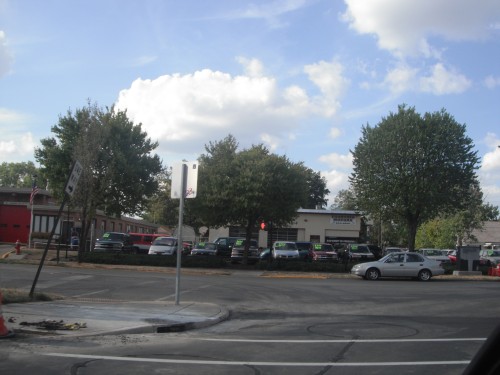
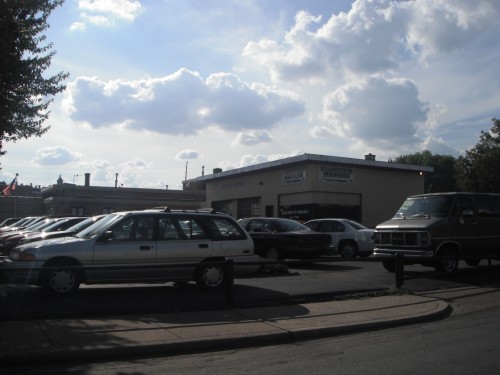
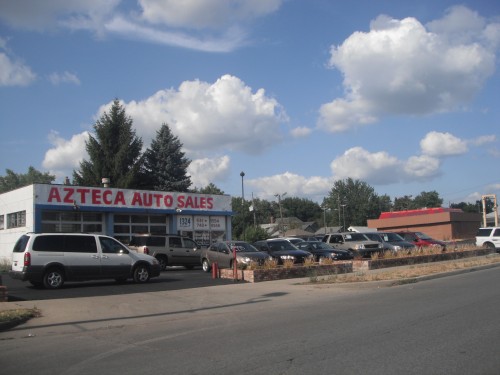


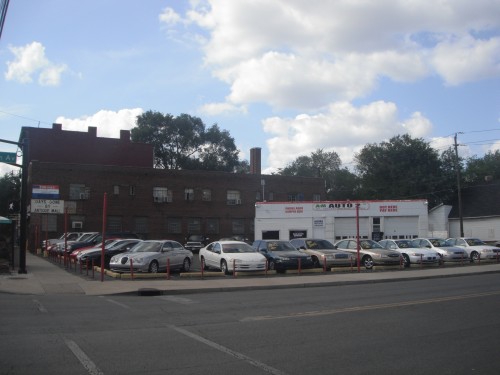
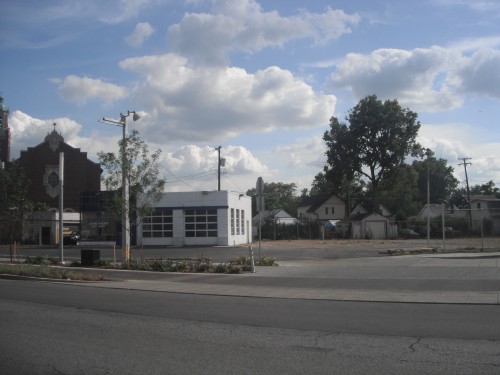
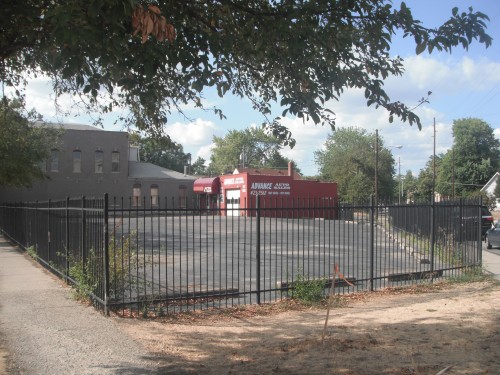


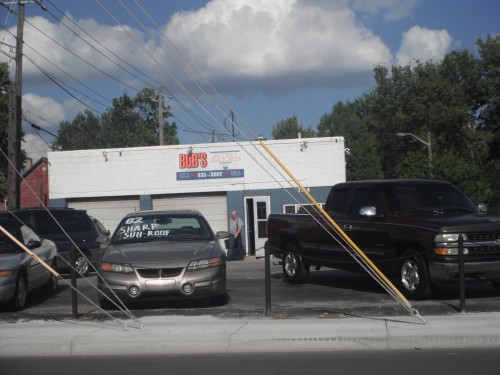

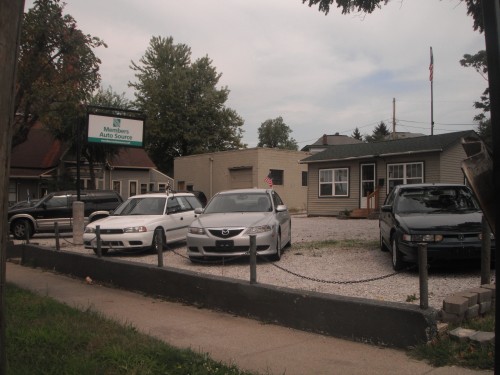
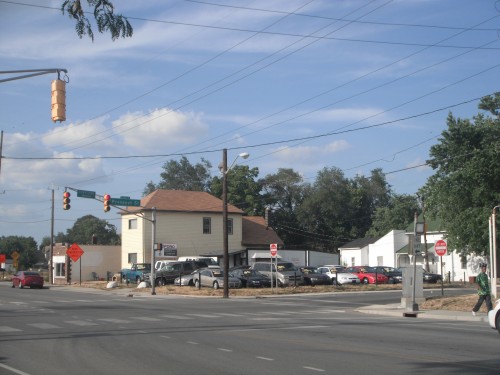

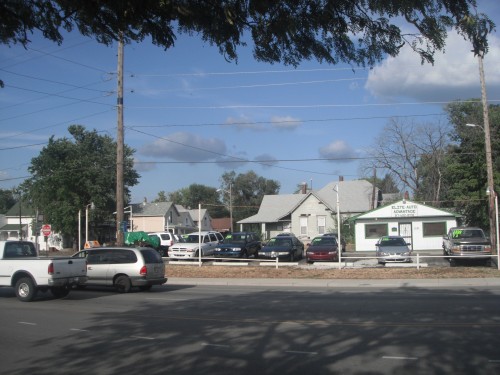
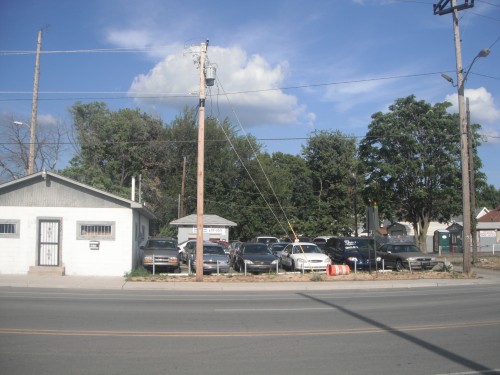
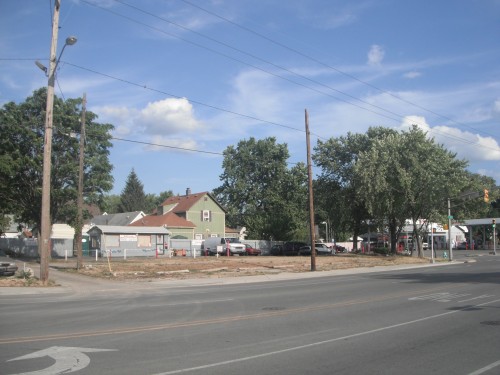

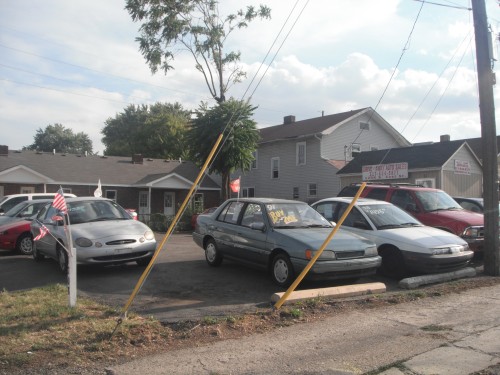
One thing I find remarkable — the historic ‘preservation’ of dozens of former gas stations. A majestic church or interesting old house can succumb to wrecking crews at the blink of an eye, but the old gas stations seem to live forever.
The reason is usually the exponential environmental remediation costs of taking the tanks out of the ground and developing on top of the land. There needs to be a special kind of land value to overcome that major issue.
Surface parking, used-car lots, and storage-barn lots are all forms of land banking with small, if predictable, returns to the owner while waiting for the “pot of gold” in the form of a buyout for redevelopment.
.
One related problem, which addresses John’s comment above: many neighborhood used car lots are in fact on old gas or service station properties. There is a presumption of old contamination and a reluctance to look for environmental liability until a buyer wants the property for some other purpose. The default, easy sale or lease is to another auto-based use.
Additionally, there is a certain value to an existing use that would be hard to come by in the modern era.
Taking up too much land, my east-side neighborhood is chalk full.
I don’t recall if you mentioned this but the used care lots induce further blight as much as they are the result of such (low land values). It’s a positive feed forward loop that produces a “negative” result. How do cities get these properties out of this “holding pattern” when the land is profitable for redevelopment with the BIG exception for environmental clean up costs?
Demand for quality housing (townhouse, apartment, condo) for low- and high-range middle incomes is good in Fletcher and Fountain Square, and this piece points out an abundance of presumeably affordable real estate along the Virgina, Shelby, and Prospect cooridors. Government tax credits or slush funds are one way but not ideal and very competitive (not to mention they add to government deficits.)
I highly doubt any of these lots will be developed in 5 or even 10 years, probably 20. Fountain Square has a rather small collection of walkable businesses anchoring the area and unfortunately doesn’t provide a compelling reason to build on these lots. If anything positive were to happen the lot would most likely be re-purposed for a people-oriented business. There’s what was once a auto body shop, but today is a popular restaurant here in Mpls. Keep in mind we’re talking about a healthy neighborhood that has seen a good deal of dense residential development (we’re talking 5 stories and up), is rather gentrified and has a denser concentration of businesses on nearby streets than what’s available in Fountain Square, but all that wasn’t enough for the site to see a residential building today with retail space where the restaurant would instead be located.
On top of that is the fact that no one has made alternative use of any of the sites pictured above, so if no one is willing to use the existing structures for another use (bar,restaurant,etc) they most certainly won’t be looking to go through the trouble of building infill on such sites. Parsons Ave in Columbus, just a hop and a skip east of Indy, is proof that despite running parallel next to a decades long established and highly gentrified neighborhood (German Village) the used car lots which seem to be on every other block have not seen any infill let alone been transformed into people-oriented businesses. You could easily swap blocks of it with S East St in Bates-Hendrick and even locals wouldn’t notice the difference unless they lived there. Again, the big difference is that Parsons is a short walk for many blocks from one of the city’s signature neighborhoods. Any street in Bates-Hendrick is totally cut off from healthy surrounding neighborhoods, so there are really no driving factors (no pun intended) to expect a future that looks better and more urban. Hell, even outside of the car lots it’s a very car-dependent area, certainly no urban lifestyle here thanks to no desirable urban assets: who would want to walk along Madison Ave? It’s atrocious and there’s not even a bike lane on this very wide, multi-lane street. http://goo.gl/maps/eIRvd . Other streets like S East could be walkable, but there’s nothing worth walking to even in existing commercial structures. Maybe the city could offer incentives to develop or re-purpose these used car lots, otherwise I see no reason to hope for any infill on them.
I’d like to see White Castle return to their Virginia Ave roots and build a retro castle building like they started out with. Peppy Grill probably wouldn’t be too pleased, though. It was a big deal to go there back when I was a kid, order several dozen and bring them back home when the parents, aunts and uncles got together to play cards. I think it was where the existing WC office building sits today but I may be wrong. That was close to 60 years ago.
It’s good to see such thought and effort put into a local blog, but I have four issues with this article.
1) These one-off car dealers aren’t “unlicensed”. Anyone who retails more than 4 cars a year in Indiana has to have a dealer license, which is trivial to obtain.
2) The primary purpose for such dealerships isn’t to sell cars, rather, they exist to *finance* cars. These are loan companies that happen to deal in cars. The “vig” is where the profit is. (Similarly, pawn shops don’t sell second-hand items, they’re loan companies.)
3) This city has had enough redevelopment schemes, which serve the insiders and politicos more than the neighborhoods. Offering incentives to build housing or whatever on car lots would be yet another boondoggle.
4) The concept of “infill” is a far-fetched, what with the Market Square Arena site still vacant 11 years after demolition. A small auto repair business or used car lot can be rented for $1500 a month – see http://www.talktotucker.com/property/property.asp?PRM_MLSNumber=21150009&PRM_MlsName=MIBOR
Thanks as always for the diverse and thoughtful comments. If it is true, as some have suggested, that many of these parcels are former gas stations, then yes, that will probably stymie further development, even if the perception of the cost and difficulty of remediation is greater than the reality. I’d be impelled to support Keith’s particularly cynical view in light of this possibility–however, the fact that two of these lots already are for sale along Virginia Avenue suggests there may be some hope. The neighborhood rejected the first proposal to transform Coop’s Auto Sales into a gas station (perhaps a reversion to its previous use?), and the developer has mentioned an alternative mixed use proposal. If this second proposal collapses, it does not augur well for redevelopment of other lots.
.
Keith’s naysaying raises some valid points in comparable scenarios (especially Parsons Avenue in Columbus), but Madison Avenue is never likely to become a desirable urban corridor and I wouldn’t suggest it, especially during the mile stretch where it is limited access. However, I do recall a developer floating a mixed use proposal at the southwest corner of Madison and Terrace with fairly decent urban design (I even recall a rendering) before the economy tanked. So apparently some saw opportunity during the more flush times, and the current parcel with a BMV (relocated from a Fountain Square parcel now under development) is still mostly vacant and undeveloped.
.
Lastly, Gene, I appreciate your clarification regarding licensing, though I think there has to be more than a semantic difference between the scale of business at a “one-off” car dealer and a used dealer that has a clear relationship with the original maker of the vehicles. Not all one-off dealers offer finance, and those that do would have to offer a catch since their clients usually have a poor or non-existent credit history. While it is unreasonable to compare these dealers to predatory lenders (a politicized term in itself), the sociocultural climate which they depend upon is not entirely different from payday lenders or check cashing services. And I have never suggested any of this needs a city development scheme–but “infill” is only far fetched if you believe the existing developments like Hinge and Mozzo are unrealistic…both are infill and are either mostly or completely privately financed.
The development at the southwest corner of Madison & Terrace might happen, but it is not indicative of market forces because it would be funded largely by a federal housing grant.
I would suggest that all these places have various licenses and permits. The city needs to target somebody – preferably without a well connected law firm at their side.The connected dealerships sell much higher priced cars to people who are essentially overlapping with the new car market. Their expenses and profits are typically much higher. If you have a big shot dealership typically the actual property owner is doing very well. The small guys are mostly “buy here – pay here” as financing is a key component. Since we really don’t have mass transit for lower wage working people these institutions (along with their cohorts the small repair shops and used tire stores) give people the opportunity to WORK for a living, get their kids to the doctor, etc. BTW The actual unlicensed dealers buy off the street from owners selling and then resell from their yard, typically with few finance opportunities.
Thanks again for all the observations. Idyllic, I appreciate the clarification in regards to that proposed development at Madison at Terrace–it should come as no surprise I suppose that it would be affordable housing.
J. England, you touch on a topic I very deliberately avoided in my original article: the notion that these used car dealerships are providing a necessary service to the lower income population in the areas. You are absolutely right that they exist to meet a demand that otherwise goes unmet among the big name dealers (Hubler, Pedigo etc) whose used cars are usually lightly “pre-owned” and appeal to a middle income population. I’m not trying to shoehorn gentrification–a dirty word in many circles, though the unflinching opposition to gentrification is equally impractical and repellent by my estimations. My goal was simply to point to these lots as potential opportunities as the neighborhoods change and the need diminishes to have so many of them in such close proximity to one another. The City doesn’t need to get involved–obviously two owners on Virginia Avenue are already looking to sell. However, I also don’t think that these mom-and-pop used car dealerships are starving by any means–at one point I lived near a family who ran one (not far from the ones in these photos) and they were doing very, very well for themselves. These businesses no doubt operate under a similar revenue structure as sub-prime mortgages, charging usurial interest rates in order to mitigate against default among their high-risk clients. Let the economic laws of nature take their course.
You should do another article about stretching the success of fountain square down the rest of prospect st. It’s primed for it. Obviously in the early stages of gentrification but primed. Santorini owner is selling his block, could be a great opportunity for a big mixed use building (that could potentially get some TIFF money to help build a parking garage so naggers will stop bitching about parking in that area (which pushes things towards a suburban, asphalt sea type development)). Prospect st could easily end up like Bardstown rd in Louisville. And some of the car dealerships you speak of have been or are being converted into commercial space, the virginia ave dealership is a hipster grocery store now and the one opposite looks like it’s for sale, the one next to the fire station has been painted and looks like a great opportunity for a garage style bar or possibly a food truck hub. The used car lot on santorini’s block is gone too. Things are changing.
Just wait and see.
Thanks for the comments, Tyler. Funny you should mention those parcels for sale on Prospect Street. I rarely comment on the IBJ’s Property Lines, but that was one article (http://www.ibj.com/articles/55293-city-block-in-fountain-square-on-the-market) where I did: I noted that it would be a real shame to demolish the two well-maintained century-old homes immediately south of Santorini. But the rest of the parcel wouldn’t be bad at all for a redevelopment opportunity, hopefully less constrained by the NIMBYism that is visible in neighborhoods like Fletcher Place nearby.
The near south side of Indy has TONS of these used car shops. Ridiculous numbers of them. I can’t help but think that Gene’s comment three years ago has some validity: the ridiculous amount of land devoted to these auto dealers helps meet a demand for low-income people who need a cheap car, largely as a result of the fact that Indy lacks reliable or frequent mass transit that might preclude the need for a car in other cities.
Hey Guys. I just listed an Old Gas Station For Sale – located at 1452 E Prospect. Genrtifacation will soon begin because I am the Broker who is selling the 1+/- acre on the south side of Prospect. It is soon to be under contract and changes are coming.
The Gas station is now on the Market at $205,000.
Call: Ted McClure (317)-457-0577
McClure Commercial
Good Job Ted! The area needs a big change. Keep up the good work. I hear you are a great Commercial Broker who makes things happen. Looking forward to the new Fountain Square.
You sold the Union 50 Building to the restaurant group in 2013..right. Awesome re-use of an old union hall!
Congrats